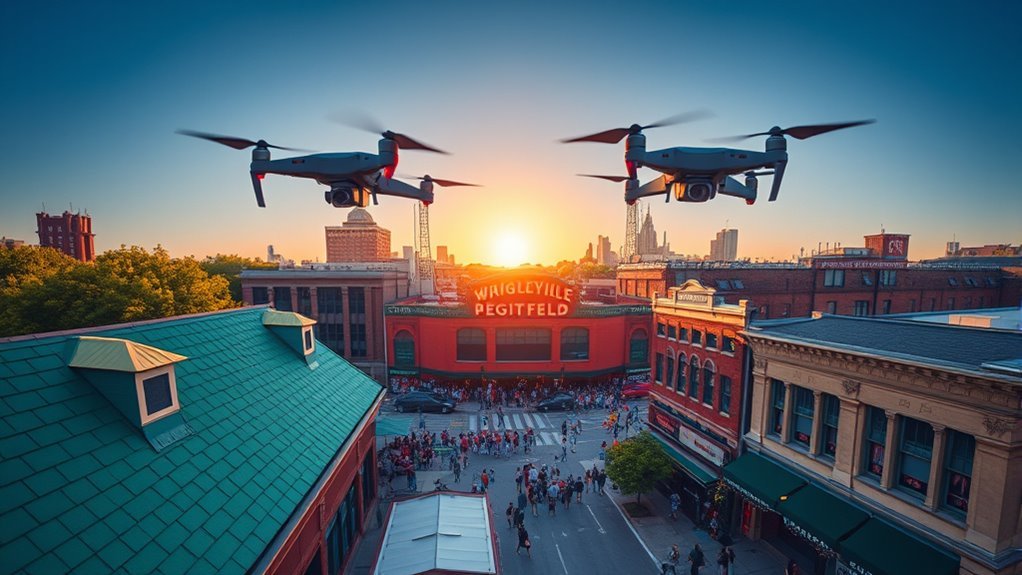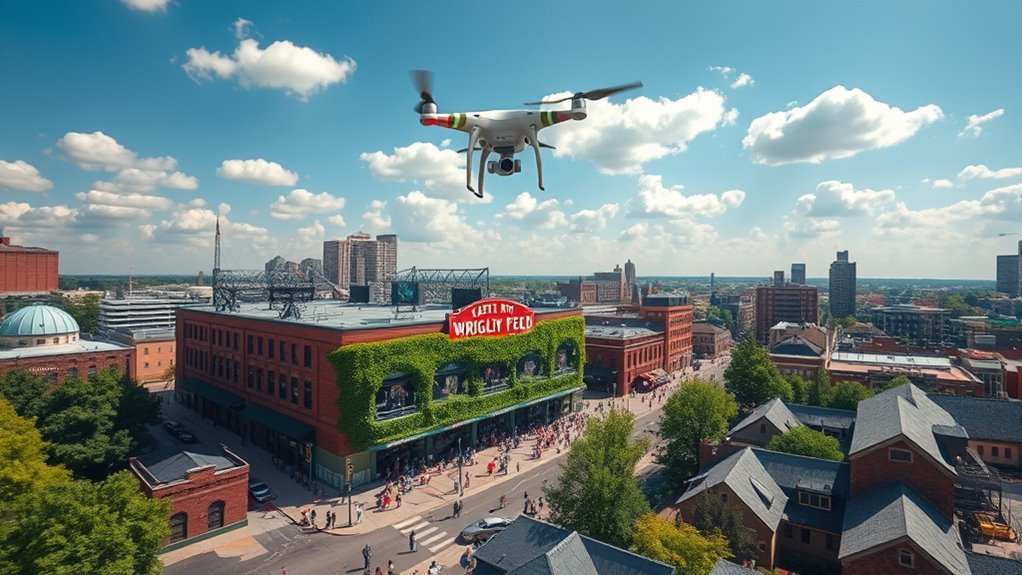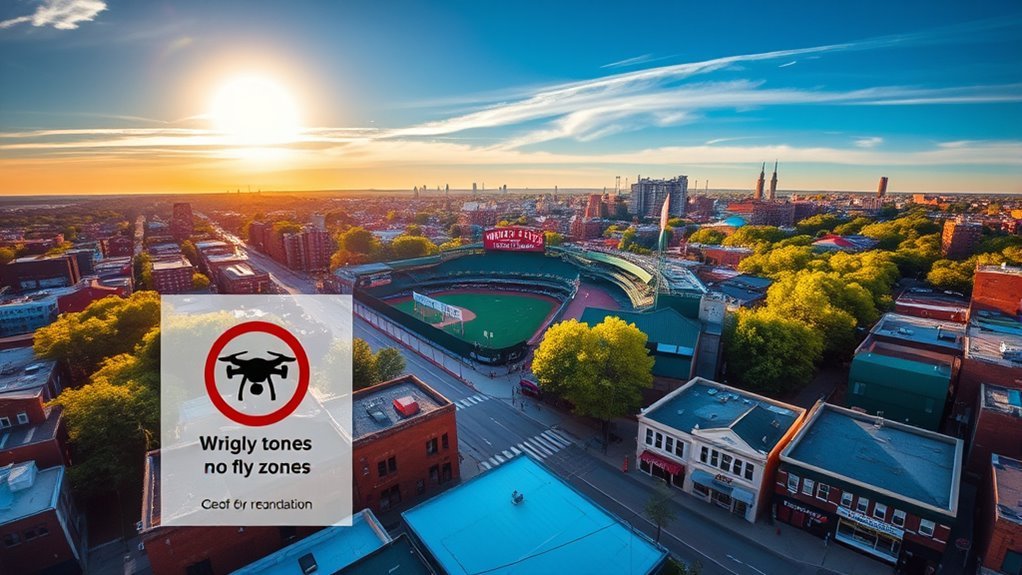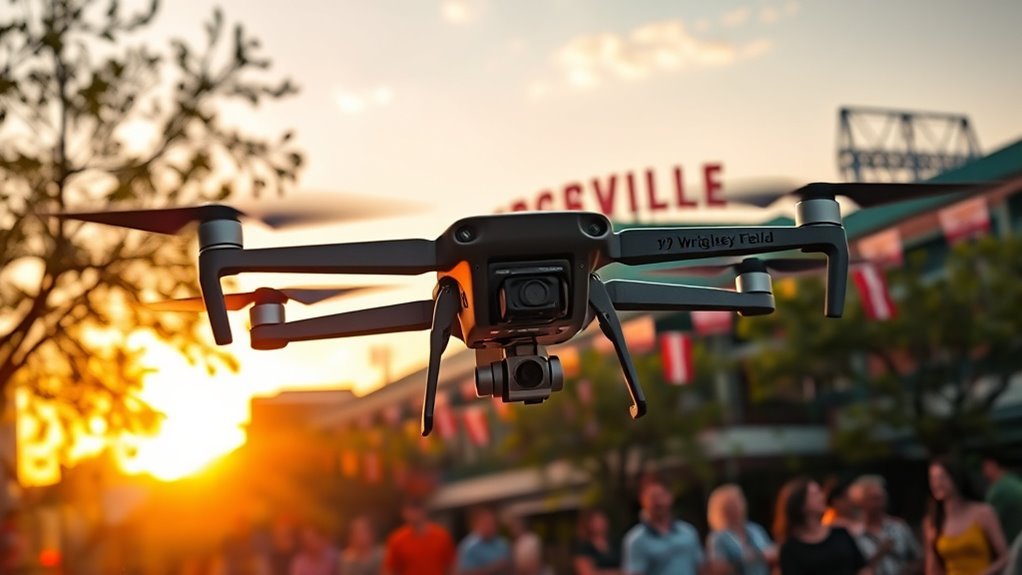When flying drones in Wrigleyville, you must follow Chicago’s strict drone laws, including avoiding no-fly zones near Wrigley Field, especially during games. Register your drone with the FAA and maintain visual line of sight at all times. Use geo-fencing to stay within allowed areas and respect privacy by not capturing unauthorized images. Avoid crowded spots and carry necessary permits for commercial use. Following these guidelines guarantees safe, legal flights—exploring further will clarify essential operational details.
Understand Chicago’s Drone Laws and Regulations

Before flying a drone in Wrigleyville, you need to understand Chicago’s specific drone laws and regulations to guarantee safe and legal operation. Chicago prohibits drone flights in many public spaces, including parks and near stadiums, to protect privacy and safety. You must maintain visual line of sight and avoid flying above 400 feet to comply with federal and local rules. Prioritize drone safety by steering clear of crowded areas and respecting no-fly zones designated by the city. Engaging with the community involves informing nearby residents or businesses if you plan to operate in sensitive zones, minimizing disturbances. Awareness of these regulations assures your freedom to fly without risking penalties or endangering others. Always check for updates, as Chicago’s drone policies can evolve with technology and urban needs.
Register Your Drone With the FAA

One essential step to legally operate your drone in Wrigleyville is registering it with the Federal Aviation Administration (FAA). Drone registration guarantees you comply with FAA requirements, granting you the freedom to fly responsibly and avoid penalties. Here’s how to get started:
Register your drone with the FAA to fly legally and responsibly in Wrigleyville.
- Visit the FAA DroneZone website to create an account and complete the registration process.
- Provide your drone’s details and pay the registration fee if your drone weighs more than 0.55 lbs (250 grams).
- Display your FAA registration number on the drone as mandated, keeping proof of registration with you during flights.
Registering your drone not only meets legal obligations but also supports safety protocols, helping you enjoy unobstructed, responsible flight in Wrigleyville.
Know the No-Fly Zones in and Around Wrigleyville

You need to be aware of restricted airspace areas when flying in Wrigleyville to avoid legal and safety issues. Keep a safe distance from nearby airports to prevent interference with manned aircraft operations. Additionally, comply with local government regulations that may impose further flight restrictions within the neighborhood.
Restricted Airspace Areas
Although drones offer incredible flexibility for aerial exploration, you’ll need to be acutely aware of restricted airspace zones in and around Wrigleyville to guarantee safe and legal operation. Ignoring these can lead to fines or worse. To maintain freedom while flying, prioritize the following:
- Identify no-fly zones: Use updated maps and apps to locate restricted areas, including government buildings and stadium airspace.
- Obtain drone insurance: Protect yourself against liabilities arising from accidental incursions or damages.
- Complete flight training: Master airspace regulations and emergency protocols to confidently navigate restricted zones.
Proximity to Airports
Understanding restricted airspace is only part of flying drones safely in Wrigleyville; awareness of nearby airports and their no-fly zones is equally essential. Due to airport proximity, you must maintain strict compliance with FAA regulations to avoid interfering with critical air traffic patterns. Wrigleyville lies close to Chicago’s major airports, where unauthorized drone flights can pose significant hazards. You’re prohibited from flying within a 5-mile radius of airports without explicit permission. Air traffic control prioritizes manned aircraft safety, so your drone must never disrupt these operations. Always use official apps or websites to verify current no-fly zones around Wrigleyville. Staying informed guarantees you exercise your freedom responsibly while preserving safety for all airspace users.
Local Government Regulations
While federal rules set the baseline for drone operations, local government regulations add critical layers of restriction in and around Wrigleyville. To fly freely yet safely, you must understand these no-fly zones and comply with local mandates. Here’s what you need to know:
- Wrigley Field and surrounding parks often have temporary flight restrictions during events—check local notices before flying.
- Residential and commercial areas may have specific altitude and time-of-day restrictions to minimize disturbances.
- Engage with local drone clubs to stay updated on community engagement initiatives and receive guidance on compliant flight paths.
Respect Privacy of Residents and Visitors
Because drones capture detailed images and videos, you must prioritize the privacy of Wrigleyville residents and visitors when flying. Adhering to proper drone etiquette means avoiding intrusive angles and refraining from recording private properties without permission. Respecting privacy isn’t just ethical—it’s vital to maintain trust and goodwill within the community. Engage with locals when possible to inform them of your drone activities, fostering transparency and cooperation. Use technology settings to limit data capture strictly to necessary areas and avoid storing or sharing sensitive footage. By combining technical mindfulness with proactive community engagement, you protect individual privacy while preserving your freedom to fly. This approach guarantees your drone operations remain compliant, respectful, and safe in Wrigleyville’s vibrant environment.
Avoid Flying Over Crowded Areas and Events
Protecting privacy goes hand in hand with minimizing risks during your drone flights. Avoid flying over crowded areas and events to maintain safety and respect for the public. When planning your flight, consider these key safety measures:
Always prioritize privacy and safety by avoiding crowded areas during drone flights.
- Coordinate with event planning authorities to understand no-fly zones and restricted airspace.
- Maintain a safe altitude and distance from crowds to reduce collision risks and avoid distractions.
- Use geofencing technology to automatically prevent your drone from entering prohibited areas.
Check Weather Conditions Before Flying
Before you launch your drone, make certain you’ve checked the current and forecasted weather conditions thoroughly. Reliable weather forecasts are essential for evaluating wind speeds, precipitation, and visibility—critical factors that impact drone stability and control. Pay close attention to seasonal changes in Wrigleyville, as temperature shifts and evolving atmospheric patterns can unexpectedly affect flight dynamics. Avoid flying in strong winds, heavy rain, or fog, which can cause signal loss or mechanical failure. Use trusted sources or dedicated apps to monitor real-time weather updates before and during your flight. By respecting these environmental parameters, you guarantee safer operations and preserve your freedom to explore the skies without risking damage or legal complications. Prioritize weather awareness to maintain control and protect your investment.
Maintain Visual Line of Sight With Your Drone
You need to keep your drone within your visual line of sight at all times to guarantee safe operation. Avoid flying behind buildings, trees, or other obstructions that can block your view. If necessary, use a spotter to help maintain constant visual contact with your drone.
Keep Drone Within View
Although it might be tempting to fly your drone beyond your sight for a better view, maintaining visual line of sight is critical for safe operation in Wrigleyville. To keep your drone within view, you need to maintain focus and practice patience, ensuring you don’t lose control or awareness of your UAV’s position.
Follow these key steps:
- Regularly scan your surroundings to track your drone’s location and anticipate any flight adjustments.
- Avoid distractions and focus solely on the drone during flight, as quick reactions can prevent accidents.
- Use landmarks or visual cues to help keep the drone in your field of vision, reducing the risk of losing sight.
Avoid Obstructions Nearby
When steering your drone in Wrigleyville, staying clear of nearby obstructions is crucial to maintain an uninterrupted visual line of sight. Your ability to track the drone visually hinges on obstacle awareness—trees, buildings, power lines, and streetlights can easily block your view and compromise drone safety. Avoid flying behind or too close to these elements to reduce collision risk and signal loss. Constantly scan your environment, anticipating potential obstructions along your flight path. Adjust altitude and direction proactively to keep the drone within clear sight. Maintaining an unobstructed view not only guarantees regulatory compliance but also grants you greater control and freedom to navigate complex urban spaces confidently and safely. Prioritize obstacle awareness to protect your drone and enjoy unrestricted flight in Wrigleyville.
Use Spotter When Needed
Since maintaining a constant visual line of sight can be challenging in crowded urban environments like Wrigleyville, using a spotter becomes essential. A spotter enhances drone safety by keeping an extra pair of eyes on your drone, especially when obstructions or crowds limit your view. To effectively use a spotter:
- Establish clear spotter communication protocols before flight to guarantee timely alerts about obstacles or hazards.
- Position your spotter in a location with an unobstructed view to maintain constant visual contact with the drone.
- Use standardized signals or radios for precise, real-time information exchange, reducing risks associated with lost sight.
Use Geo-Fencing Features to Stay Within Allowed Areas
Even if you’re experienced with drones, using geo-fencing features is crucial to prevent accidentally flying into restricted zones around Wrigleyville. Modern drone technology integrates GPS-based geo-fencing to create virtual boundaries that keep your drone within legally permitted areas. This automated system reduces the risk of violating airspace regulations and enhances flight safety by restricting access to sensitive locations. Geo-fencing benefits include real-time alerts and automatic flight adjustments when approaching no-fly zones, giving you freedom to explore while maintaining compliance. Activating these features before each flight guarantees you respect local restrictions without constant manual monitoring. Embracing geo-fencing empowers you to fly confidently, minimizing legal risks and safeguarding both your drone and the community. Always update your drone’s firmware to access the latest geo-fencing data relevant to Wrigleyville.
Keep Your Drone Away From Wrigley Field During Games
You need to avoid flying your drone near Wrigley Field during games due to strict no-fly zones and specific airspace restrictions in effect. These regulations are enforced to guarantee safety and prevent interference with event operations. Violating these rules can lead to significant penalties, including fines and legal action.
No-Fly Zones Near Stadium
Although drones offer unique aerial perspectives, flying them near Wrigley Field during games is strictly prohibited due to established no-fly zones enforced by the FAA. These no fly regulations and stadium restrictions are designed to protect public safety and prevent interference with emergency operations.
Here’s what you need to know:
- The no-fly zone extends several miles around Wrigley Field during events—flying within this perimeter violates FAA rules.
- Stadium restrictions prohibit drone operation above and near the venue to avoid distractions and potential hazards.
- Violating these regulations can result in fines, drone confiscation, or legal action.
Respect these boundaries to enjoy your drone freedom responsibly and avoid penalties while keeping Wrigleyville safe during games.
Game Day Airspace Rules
Following the no-fly zone guidelines near Wrigley Field, game day airspace rules further restrict drone flights to assure safety and prevent disruptions. On game days, the airspace around the stadium is tightly controlled, often designated as a temporary flight restriction (TFR) zone. You must avoid launching, flying, or hovering your drone within this designated perimeter during game times. These restrictions exist to assure drone safety by preventing interference with manned aircraft, emergency operations, and the large crowds gathered below. Even if you’re outside the no-fly zone, maintain heightened awareness of your drone’s altitude and position to avoid unintended incursions into restricted airspace. Respecting game day airspace rules not only protects public safety but also preserves your ability to enjoy flying drones freely elsewhere in Wrigleyville.
Penalties for Violations
Since drone flights near Wrigley Field during games are strictly regulated, violating these rules can lead to significant penalties. You need to understand the fines and penalties imposed to avoid legal consequences that can restrict your flying freedom.
- Monetary Fines: You could face hefty fines ranging from hundreds to thousands of dollars for unauthorized flights near the stadium.
- Legal Consequences: Repeat or severe violations might result in criminal charges, including potential jail time or probation.
- Drone Confiscation: Authorities may seize your drone, limiting your ability to fly legally in the future.
Respecting these regulations guarantees you maintain your right to fly safely and legally. Keep your drone well clear of Wrigley Field during games to avoid these serious repercussions.
Carry Necessary Permits for Commercial Drone Use
When operating a drone commercially in Wrigleyville, you must carry the appropriate permits issued by the Federal Aviation Administration (FAA). Securing your commercial drone permits begins with completing the drone registration process, which legally authorizes your UAV operations. Without these permits, you risk enforcement actions that can limit your freedom to fly. Confirm your drone is registered, and you hold a Remote Pilot Certificate under Part 107 regulations. Always carry proof of your permits on your person when flying commercially. This documentation verifies your compliance with federal rules and supports safe, responsible drone use. Staying current with permit requirements not only protects you legally but also confirms you can confidently operate your drone in Wrigleyville’s airspace without unnecessary interruptions or penalties.

